IMDb meta-data is 1 hour and 4 minutes, rated 4.7 by 1013 raters.
The brother of a kindly and diffident small town physician dies and at his funeral are many grim faces. While no one comes forward to stick pins in the body to make sure it is dead, per Herman (George Kennedy) in ‘Charade’ (1963), the relief at the brother’s death is expressed by one rather distraught woman who flings open the church door and delivers a rant that briefly livens up proceedings.

It is a nice touch to interrupt this conventional and somber scene with a vicious denouncement delivered by a mousey-looking woman.
She proclaims the deceased to be Satan’s spawn. ‘Must have parked in her drive way,’ mused the fraternity brothers, remembering the times those words had been directed at them.
The deceased is the identical twin brother of George Zucco, and George plays a double role. No, there is no flashback, because dead Brother is much in evidence. See title, though note it should be singular, Dead Man Walks, Talks, Nips, Sips, and More.
No sooner is Brother buried, despite the woman’s suggestion that he be burned, than Igor digs him up and opens him up so that Brother can join the Undead. Pedants note: The Undead also include zombies and that is what I was expecting. But no, here we have a vampire, but a second rate one since he has no cape, and — more importantly– he is not the singular Bela Lugosi.
The Undead are those who do not return the many books they have checked out from the library and have learned how to become a vampire by correspondence school. Brother graduated at the top of his class. Risen, this Evil Lazarus preys on the locals, well on George’s niece, sipping her blood every night to sustain himself. Though later an excited crowd accuses him of more, there is no indication in film he did anything more than dine at home on his niece.
This incestuous necking makes her intended mad, though why he is so far away at the sipping times is a mystery. He takes out his bile on innocent George. Denouncing woman offers helpful hints from ‘Women’s Weekly’ on how to cope with a vampire uncle in the family. After several bouts of sibling rivalry, George accepts the idea that Brother is Undead.
Igor is the weak link in this exercise, as he rumbles around the coffin on a wheel barrow at all hours. Obviously he is a Villain School drop out.
In the end George has to go down mano-à-mano with his evil twin Brother in the flames. Cain and Abel all over again, once more, anew. The end.
Zucco (1886–1960) played suave villains or mad scientists in many B pictures, including Professor James Moriarty. He has 98 credits on the IMDb and half would fall on the shady side of the moral street. But he always made an impression with his presence.
Here is a change of pace and yet not. In one part he is an innocent who slowly comes to realise the truth about his brother, though how he missed it in the first place is open to question, and also the evil brother. He managed to distinguish the two characters in appearance, voice, manner, and gait. Accomplished was this stager who was born in England but started acting in provincial Canada. Close observers will note he lacks two fingers on his right hand, a war wound.
Category: Film Review
‘The Great Flamarion’ (1945)
IMDb meta-data is run time of 1 hour and 18 minutes and rated 6.6 from 792 cinemitizens.
This is film noir at its best, simple, direct, dramatic, and basic. Erich von Stroheim is the title character who has vaudeville shooting act (sponsored by the NRA) where he hits everything but Dan Duryea. It has the requisite very femme very fatale in Mary Beth Hughes (seen in some Charlie Chan movies).
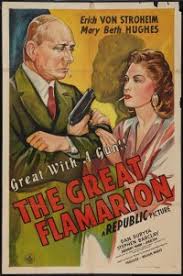
Femme decides to shed Dan and his many empty bottles, and seduces the Frog with the gun. Erich is no pushover since in an unstated backstory a woman ruined his life by taking his monocle. But over he goes, heels over head. Picture that. Dan has been unreliable for some time and Erich gives him notice with a .38 caliber bullet in the act!
Since Dan was stiff with drink, no charges follow. Frog promises all to Femme and she takes it. Scram. It takes Frog some years to figure out he has taken to the cleaners and dumped. He freed her from husband Dan and she freed him from all his dosh. Off she went.
Thereafter Frog dedicates himself to tracking her down for….revenge! He does and he does. The wages of sin are paid in full per the Code.
At one point Femme has four men on the string, and they not playing yo-yo. Whereas A pictures in 1945 were subject to much restraint both external and internal, B pictures like this one were allowed more license regarding sex. B pictures were often screened after the A picture to a dwindling audience.
Moreover, there is some eroticism with the guns in both the action and the dialogue. Why did I think of Charlton Heston stroking that rifle at the NRA convention? That scene is available on You Tube for those who wish to lose any respect they might yet have for Chest Heston.
Regrettably most of this film is told in flashback, and in this case that takes the air out of the drama. No doubt considerations of timing and cost dictated that approach. It means Frog delivers some of his best lines while dying on the floor.* The gossip mill says the Frog resisted the flashback approach to no avail. He always wanted linear stories and that is another reason to like him.
The director was Anthony Mann at the beginning of an illustrious career and he certainly shows his talents for pace, timing, mood, energy, angle, light and dark. Some of the double shots are startlingly even to this jaded viewer. He elevated a common story on a skimpy budget to something more for over an hour despite the draining flashback.
When trawling through You Tube offerings for Sy Fy I came across a thumbnail for this and recognised Erich von Stroheim. He is always must see, so I did. His transformation from Prussian autocrat to love sick puppy is forced by the run time but he carries it off.
Chapeux to Mary Beth Hughes who delivers lines with double and triple meanings with no apparent effort. She does not miss a beat as she turns from one man to another with a lie. How it is that she did not make the A list of stars is a mystery in itself. Fox Studios failed to renew her contract in 1943 and she found her way to Poverty Row with Republic Pictures. In time, she quit and worked as receptionist in a doctor’s office where she said she met a better class of people than in Hollywood. Perhaps she was a #metoo in her day.
DD also gives a fine performance, combining as only he could vulgarity and vulnerability in one line.
*Yes, I thought of William Holden face down in the pool, too. Why not when Billy Wilder’s older brother was credited as producer for this film as W. Lee Wilder. Of course Erich is there with William in that picture, too. It is perhaps thanks to Mann that this Lee Wilder production is miles better than most of the others he turned out, like ‘The Snow Creature’ (1954) reviewed elsewhere on this blog.
‘Starcrash’ (1978)
IMDb meta-data 1 hour and 32 minutes of Dali time, rated 3.9 from 4657 time wasters.
A cheap and cheerful exploitation of Star Wars from the heartland of such ersatz imitations, Cinecittà in Rome. This film is often cited at the spoor that released scores of Italian Sy Fy simulacra. It is also often proclaimed as the worst of the derivative spawn it spewed.
First the setup, then the tear-down.
Lord Bad’s lines are ‘Kill. Kill. Kill them.’ He knows what he wants and how to communicate it. His aim is to displace Plummy and rule the Ford Galaxy. Lemmy Caution would then not be able to visit Alphaville.
The only things standing between Lord Bad and success are the bikinis of Stella Starr! The fraternity brothers cheered!
Bond Girl struts around as Stella in a fur bikini on the ice planet, a metallic one at a rock concert, a feathery one with the Amazons, and more, sometimes less. David Hasselhoff’s bouffant displaces Marjoe Gortner near the bikini. The fate of the Samsung Galaxy depends on Bond Girl, Bouffant, and a boy with a woman’s name. Only the scriptwriter could save them.
Gortner had been a child evangelist who turned and tried his hand at this. He needed no make up to look alien. In a pinch Gortner has laser eyes so he can do his own cataract surgery. Handy. Nothing is ever forgotten or done only once at Cinecittà and the same gag is used at the end of ‘Escape from Galaxy 3’ (1981), reviewed elsewhere on this blog.
The effects are coloured paper and so are the characters. The dialogue is speech balloons from comic books. Recall Lord Bad’s dialogue as quoted above more or less in its entirety. There is neither science nor fiction though there is energy and zest. Altogether it looks like a failed animated Marvel Comics pilot, it lacks the pathos characteristic of Marvel heroes.
Looking disconsolate, Christopher Plummer, as Lord Good Guy, aka Plummy, after hiring Dr Who as a consultant, stops time. Indeed watching this treacle feels like time has stopped. Gossip is that Plummer signed for three days but finished in one to get it done and get out. He had to rush back to London to throttle his agent.
Then there is the Texas robot who keeps Bond Girl warm on an ice planet by holding her….hand.
Lord Bad Guy sports a Princess Leia hairstyle when shouting his monosyllables. With that hair bun it is hard to take him seriously.
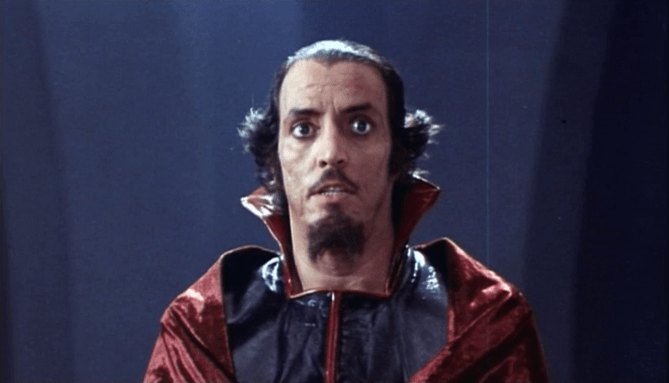 See.
See.
Disclosure Statement. About half way through I left it running and took the dog out for a turn in the park for thirty minutes. Did I miss anything?
Be warned! It has been released under a variety of titles to lure audiences to the miasma.
‘The Monitors’ (1969)
IMDb meta-data 1 Hour and 32 minutes of Dali Time, rated 4.7 by 243 relatives of the producer.
In psychedelic 1969 Chicago the world has been taken over by The Monitors who are silent men in long black over coats, black turtle neck sweaters, and black bowler hats who speak slowly and politely. Only if necessary do they spray sleeping gas to quell a disturbance.
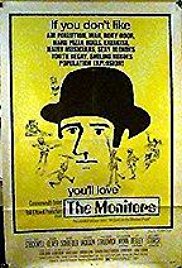
With the advent of the Monitors peace and prosperity reign for one and all around the world. No more storm clouds over Lake Michigan. No more poverty, racism, corruption, war, disease, or reruns on television. In fact the only television broadcasting is testimonials to the benevolent rule of the Monitors.
In this Eden emerge NRA reactionaries who pine for the good old days when murder and mayhem were a constitutional right. They make SNL efforts to undermine the pacific order of the Monitors who in turn infiltrate secret agents into their ranks. These skits would have been rejected for SNL. Then lust or is it love rears up. This surge briefly aroused the fraternity brothers from their habitual lethargy, but not for long.
There is satire here but it is laid on like a load of bricks. Why would anyone revolt against perfection? So asked the Hall Monitor in Chief, and the hero has no answer. I wondered if the Chief Monitor was related to the Honcho Monitor in ‘The Island Earth’ (1955), reviewed elsewhere on this blog. He has the hair for it.
There are hip Sixties fashions piled high. There are a great many cameos by one and all from ChiTown from Xavier Cugat, Ed Begley, Sherry Jackson, Alan Arkin, to Everett Dirksen. But no Ernie Banks, Gale Sayers, Harold Washington, or Bob Boozer. Indeed this Chicago is all whitebread as are the Monitors.
Also absent are a story, plot, or purpose. The level varies from Sy Fy to slapstick and back. Then it tries for comedy with the finesse of the Three Stooges. Mugging does not comedy make.
Disjointed is the word for it.
The acting is mostly ham from Corporal Randolph Agarn, though the leads Vina and Dean’s older brother try. They act like they are in a different movie, and they would certainly want to be. The sets are bare but the cinematography in, around, under, and above Chicago is delightful.
Though the Monitors are all knowing and all powerful they cannot push open a door and retreat when assailed with rotten fruit. Sure. We never learn anything about them. Where did they come from. How did they take over? What is their purpose? Where did they park the flying saucer? Where did they get those hats? What did they do with Fox News? Did it hurt?
‘The Abominable Snowman’ (1957)
IMDb meta-data 1 hour and 31 minutes rated 6.5 at from 2846 cinemitizens.
The majesty of the roof of the world in Tibet provides the background to this tale. Peter Cushing is the very British scientist scouting high altitude plants and Sergeant O’Rourke is the bluff American showman. They join forces to search for the Title Character is this Creature Feature with many a difference.
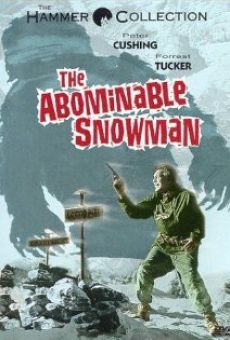
The crass showman explains his desire to profit from the increasing curiosity of people about the world which can now be satisfied by radio, television, and movies. His interest is commercial but he sees a larger meaning in it. Like Benjamin Franklin, he wants to do well by doing good. Cushing’s interest is a personal obsession since he once saw the footprint of a gigantic Title Character. While he is a Sensitive Victorian Age Chap in manner with pipe, tea, and scarf, his interest is personal, not scientific.
Though muted, the collision course is set. Cushing wants to take pictures, open a dialogue, exchange email addresses, and become Facebook friends with the Title Character. Sarge wants to cage one and take it back for show and tell. Maybe run it as a Republican for the Senate from Wyoming. As tensions rise, the worst comes out in each of them.
Sarge gets more huckster and Cushing gets more sanctimonious. They compete vigorously in stereotyping.
Is the Abomie an offshoot of human evolution? Is Abomie an alien hiding out in the mountains, waiting for Zontar? Is Abomie the successor to humanity so that after we all kill each other and leave the Earth will Abomie and company come down out of the mountains to claim the world? Is Abomie id?
There are many nice touches. The telepathy of the Lama and the Abomie added to the spookiness, as did the dark interior of the lamasery. Then there is the whistling and whispering wind in the mountains.
Then one dark and windy night in the high peaks, they shoot and kill an NBA player, eleven feet tall with the shoe and ego size to prove it.
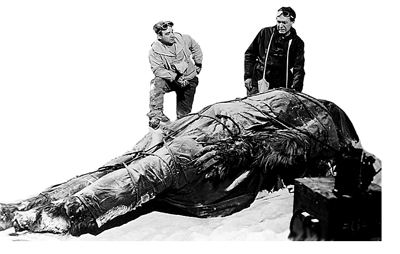 Big.
Big.
But dead. Well a dead NB-Abomie might still be worth something, both of scientific and commercial value. Time to pack up and go home.
Ah huh.
Turns out Abomie has family and friends and they want … to give his body an Himalayan burial, cash-in his Opal card, take revenge on the murderer, keep their secret by killing the whole group, or watch 7Mate.
It is 1957 and everyone smokes, even on Mount Everest they stop for a fag.
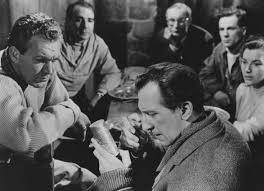 Before the body count starts.
Before the body count starts.
Between smokes the party of five is reduced, to four, to three…. The guide runs away. Two of the dead have no marks on them, yet they are dead. One of them commits suicide, more or less, and the other dies of fright after reading the script to the end. Two little Indians remain on the India side of the mountains.
To bait a trap Sarge had convinced one of the party to be a scapegoat. And arms him with a rifle loaded with blanks. Nice guy. His excuse was to avoid killing another creature. Not out of concern for the creature but to have a live example to exhibit. Nice guy. Now he has a dead scapegoat.
Yet later Sarge tries to expiate his guilt and finds himself trapped in an avalanche of his own making. As he turns to face it, perspiring, exhausted, gaunt, his fatalism is complete. But that pales next to Cushing’s final confrontation.
Yes, there is no Yeti.
In a display of spunk rare for a 1950s damsel, Cushing’s scientist wife whom he left back in the lamasery making tea and cataloguing the specimens, sets out to find him, fearing the worst. By force of will she drags along his assistant and she finds him. Atta girl! Whew!
There is intelligence and wit in the screenplay that rises above the stereotype of the Creature Feature genre and the subsequent reputation of Hammer Films. Let be said that the reputation is largely undeserved, but there it is.
The comparison has to be ‘The Snow Creature’ (1954), reviewed elsewhere on this blog, which stems from the same premise, scientist and showman in search of the Yeti in the Himalayas, and the two films differ thereafter in every respect. In ‘The Abominable Man’ the natives are accorded respect and even deference, as it is their country. While the showman is crass he can explain and justify his approach and he shows remorse later. The party consists of mixed characters and not disposable cardboard. And Abomie is granted a spirituality denied to the lab specimen in the telephone booth.
The ice and snow came from a second unit working in the Pyrenees, and it is marvellous. No CGI there but guys slogging through snow.
Nigel Kneale wrote the story and then the screenplay, and it is directed by Val Guest who mastered mystery, pace, locale, tension, drama, who dared leave much to the imagination of the viewer. This started as a story called ‘The Creature’ for the BBC two years earlier. This combination of Kneale and Guest produced quality time and again.
Sergeant O’Rourke did several B picture in England like ‘The Strange World of Planet X’ (1958), reviewed elsewhere on this blog.
I found it on Daily Motion and the print I watch was jerky but easy enough to watch and hear.
‘Journey to the Center of Time’ (1967)
IMDb meta-data is 1 hour and 22 minutes of Dali time 3.7 from 538 cinemitizens
Having just inherited the vast Stanton fortune, Scott Brady descends on the Stanton Institute for Time Research to get his watch repaired. Brandishing KPIs he demands results! The lab coats there cannot even change the battery in his Rolex! Useless! If they cannot do better he will divert the funding to Weapons of Crap Destruction and start with Hollywood!
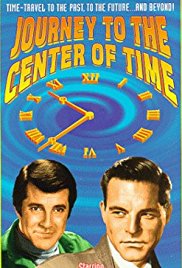
Whoa! Under that gun the Senior Scientist skips pages in the Time Traveller’s Manual and throws all the switches. ‘More power,’ Igor, the ever present assistant, cries and more power he gets from somewhere.
They get comfy and tune in the same television I had in grad school with endless horizontal rolling and showing nothing but very old, very tired reruns on the only channel it can receive. They watch about 30 minutes of the film excerpts from public domain stock footage of rubber dinosaurs, fake cowboys, playful cavemen, decent Republicans, forbearing Christians, and other forgotten pre-Fox News relics glimpsed briefly when the horizontal roll pauses. ‘Comfy,’ well there is only one chair. Guess who occupies it? Yes, Scott Bully.
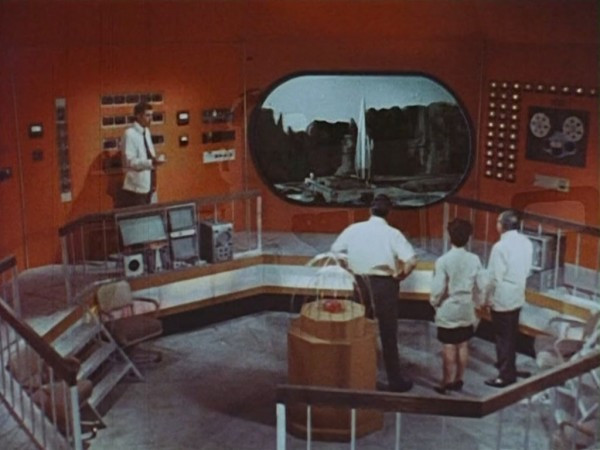 The time lab where they watch television. Note the sunken floor.
The time lab where they watch television. Note the sunken floor.
The other notable accoutrement of the lab is an elevator that descends two steps to the sunken floor of the lab. Brady makes ostentatious use of it when he comes to crack the eggheads. Later, as below, when he is running for his life, he skips the elevator and uses the steps. Makes sense, but why is it there in the first place. We’ll never know.
Well Brady is impressed that the time travel lab seems to travel in time, but where is the dollar in the past? Let’s try the future. Hmmmm, but it is his dime so Senior and Igor with the requisite female on screaming duty comply. They go looking for Yvette Mimieux and the Eloi in the future. The fraternity brothers cheered.
Whooska, and they flit through time to…. some time. There they find a spaceship and Blue Poles, yes, Slavs standing on plinths. See, it’s like this. Bully Brady, Senior Scientist, Igor, and Screamer are standing in their sparsely furnished time lab blaming each other for forgetting to order Indian takeaway before launching into the future, when the men in blue… No, wait, that is the blue men kick in the door and take them away at finger point. Thereafter the blue men, showing their superiority, climb on top of the plinths to lecture them. Well, it makes as much sense as some of the training seminars I have had.
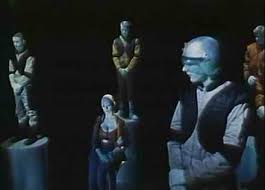
Then in another empty room they encounter the rest of the Blue Poles who recite gibberish from the script about being in the middle of a war.
Here was Bully Brady’s chance at some technology transfer for his weapons industry. But does he take it? No, he is too busying plastering his remaining hair to his forehead to make a deal, grab a phaser, steal a super secret blue print pinned to the notice board, slip a plinth in his pocket, or anything.
Seeing how useless these travellers are, the Blue Poles send them back to the Time Shed amid a hail of sound effects. Once there levers are levered and switches switched, though what the power source would be out there is unknown to them and to us. They go whirring back to 1967 hairstyles.
But wait, Bully Brady annihilates himself. That was a nice touch, but completely incomprehensible. In short, he played chicken with himself and lost. That was one ka-boom we all cheered.
This film is proof that things can always get worse. After a run B films rated below 5.0 comes this entry. The director, writer, producer David Hewitt came to this movie after his remarkable ‘Monsters Crash the Pajama Party’ (1965) in his own search for the bottom of the barrel. This latter film has proven illusive on the inter-web but the fraternity brothers continue the search during their conscious hours.
Hewitt’s efforts are ably assisted by Scott Brady who exudes bad will with a thuggish air few could equal. He is perfectly loathsome but waiting a long time to see him get his comeuppance was boring. The direction seems to have consisted mostly of Brady turning his head to the left, and then… to the right. Wow! That’s entertainment, not. Was he rolling his brain into the socket, watching a tennis match, feeling water in the inner ear, or doing as he was directed? Decide now!
For most of the cast this is the single entry on their IMDb vitae. The fraternity brothers had no trouble predicting that.
The production values are well below Dr Who. Indeed a Dalek or two would have livened up the otherwise dead script. Moreover, the 1967 Tardis was a luxury craft compared to this Time Shed.
‘Men into Space’ (1959-1960)
IMDb metadata: run time per episode in 26 minutes, rated 8.1 by a paltry 122 cinemitizens.
A one-year television series in thirty-eight episodes from the United States depicting space flight pioneering with respectful attention paid to the science and technology. Willy Ley would have approved. Maybe he did. It stars everyman William Lundigan.
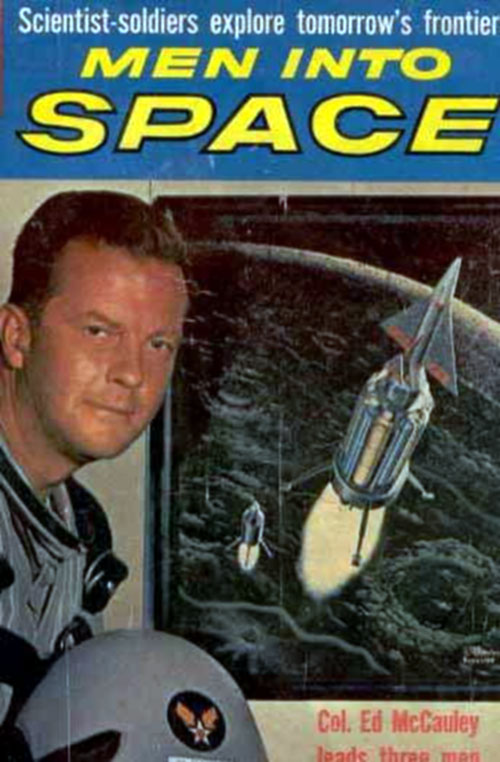
And he alone is the constant through the episodes. No other player is listed for more than eight outings. That may partly explain its failure, not enough characters to develop audience identifications, together with the lack of dramatics from calm, cool, collected, and sometimes nearly catatonic Bill. The tone is realistic and the presentation emphasises the difficulties. Space flight is hard enough without zombies, meteors, or John Carradine.
The drama emerges from the divergences among the crew, and occasionally from mechanical elements. Some of the crew are determined to complete the mission even at high risk, and others are more cautious. Everything is being done for the first time, and some of the equipment fails. Think Apollo 13. Think low-bid contractors.
The series was made with what appears to be the unstinting cooperation of the USAF, as noted in the terminal screen acknowledgements. These Saturn rockets are military without a doubt.
In 1958 President Dwight Eisenhower created NASA to explore space. There must be quite a story there of Ike wresting some of the missiles from the generals. But who mistrusts generals more than a one-time general, and who better to convince Congress likewise than that same general.
No doubt this creation was part of a policy to encourage the Soviets not to use space for military purposes. But of course there must have been some serious cooperation between NASA and USAF that continues today. Those rockets grow on money trees in the defence budget green house. No doubt there have been occasions when the USAF made a bid to take over from NASA, too. These bureaucratic fights would be fascinating studies in themselves.
This series might have appealed to the Air Force as publicity for its sole-agent claims to space. Though the references to an enemy ‘them’ are few. Indeed in one episode the safe return of Bill himself is only possible with the cooperation of a Russian tracking station. No doubt when the script writers get bored they will throw in some sabotage, and that friend of the jaded writer, the meteor, but not in the early going.
Even so it is notable that each of three episodes seen so far end in failure. The Moon orbit is aborted and the whole crew returns safely. The Moon landing is compromised and one crewman dies on the Moon, and the rest have to leave before completing the mission. Ditto the third, another injury truncates the it. The program, a cynic might say, was creating a climate of low expectations for space exploration.
 Man down!
Man down!
The key is so low that the first steps on the Moon are nothing much. The door opens, down the ladder they go and start standing around waiting for the director to cue them. No dramatic pause before the step onto the surface. No finely calibrated remark. No excitement.

No speeches and no flag. Neil Armstrong got no tips from this scene for his step into eternity.
While there is a revolving door of characters the sets are of great verisimilitude for the day, thanks no doubt to the Air Force. The acting is fine, the more so considering how quickly each episode was made. Maybe not in one-take, but close to it. The worried wives, look very worried. The anxious generals on the ground look anxious. The stressed flyboys look stressed. By the way, the ubiquitous Australian Michael Pate appears in one episode.
The one mistake is in the portrayal of the representatives of the media of the day as sober, sensible, and civil, but then maybe they were back in those days. Certainly today no self-disrespecting ABC journalist would fail to badger the worried wives with questions about death, children about absent fathers, generals about incompetence, and so on. Why let the dust settle when stirring it up goes on the resumé.
Like the acting and realism, the special effects with models and travelling matte are far superior to many a B-movie reviewed on this blog. Free-fall in the cabin is fun to watch. In space there is no flame from the rockets. The EVA astronauts are floating in the ether.
The Mind Palace has no entry for this program from the time. It was programmed against ‘The Adventures of Ozzie and Harriet Nelson’ and ‘The Price is Right,’ so I guess our boob tube was on the Nelsons in 1959-1960.
‘Escape from Galaxy 3’ (1981)
IMDb metadata is this: 1 hour and 32 minutes of treacle, rated 3.2 by 277 cinemitizens who confessed to seeing it.
First there was ‘Starcrash.’ and then when it seemed Italian Sy Fy films could not get worse, the same production crew that made it came out with ‘Escape from Galaxy 3,’ from which there is no escape. The production liberally plagiarised the special effects, vista shots, and costumes from the earlier film, and this story, such as it is, starts where ‘Starcrash’ (mercifully) ended.
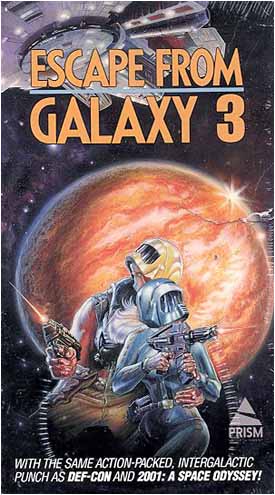
What is the set up? Princess Lolo and King Dad are in for trouble when Liberace shows up dressed for the Newtown Mardi Gras right down to sparkle in his beard.
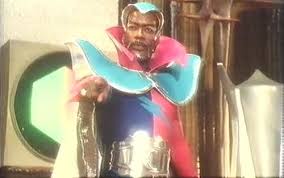 Looks like he fell off a float.
Looks like he fell off a float.
He has cosmic mega candelabras and blasts them. He did not come in peace. He came in sparkle. Since he is styled ‘King of the Night,’ the fraternity brothers wondered if he was searching for the Queen of Night from Mozart with her very, very high Cs. Should be able to hear her anywhere in the galaxy when she hits it.
Yes, this is yet another Italian Star Wars exploitation. It goes to the bottom of a long list.
Lolo with Seia, her bodyguard, flee. Liberace pursues. They flee some more. Liberace pursues some more. When he gets close they fire their puny candlesticks and he replies with his cosmic mega candelabras that destroy whole planets that get in the line of fire. This takes forty-five minutes or five on Very Fast Forward, best friend of the obsessive film reviewer.
Desperate for an espresso, Lolo and Seia land on Earth, 20,000 years ago to tank up. Yep. the fraternity brothers recognised the Italian peninsula for what it is, a phallic symbol. So do the travellers. Once there they learn from the birds and bees. This couple of losers did not know what those bits were for back home. Now Seia takes his duties as Lolo’s body guard to new…. No wonder Liberace thought it was time to exterminate them. There follows about forty-five or five minutes of frolicking. Old Liberace has been forgotten. Oh, sure.
Until he arrives with his mega cosmic candelabra and starts blasting Earth, then the script remembers him. The natives blame Lolo and Seia for making God mad at them, and so they should. A soccer riot follows and Liberace grabs Lolo and Seia, though why he wanted these two stick figures is not clear. They face off, and — whoa! — Seia burns Liberace to a crispy critter with his laser eyes. ‘Laser eyes?’ Yep. Saved those for the end.
Lolo and Seia decide to stay on Earth and start Italy.
The end.
In a word: terrible.
The Italian title makes it sound far better than it is, namely, ‘Giochi erotici nella terza galassia,’ which according to Siri translates as ‘Erotic games from the third galaxy.’ There is no science and the fiction is incoherent, bland, and predictable (except for those laser eyes, which he must have borrowed from Superman and augmented them somehow).
It was also released in English-speaking markets as ‘Starcrash II’ to warn off movie goers. It worked. Other Italian imitations of ‘Star Wars’ include the aforementioned and difficult to forget ‘Star Crash’ (1978), ’Star Odyssey’ (1979), ’War of the Planets’ (1977),’ ‘The Humanoid’ (1979), and others I have successfully forgotten.
Quatermass 2 or II: Enemy from Space’ (1957)
IMDb metadata is 1 hour a 25 minutes, rated 7.0 by 2773 cinemitizens.
When Quatermass’s moon project is starved of funds, he goes to Whitehall to bludgeon bureaucrats into stumping up the dosh. This method has always worked before so off he goes. Meanwhile, his crew watch the gentle ascent of a flock of meteors.
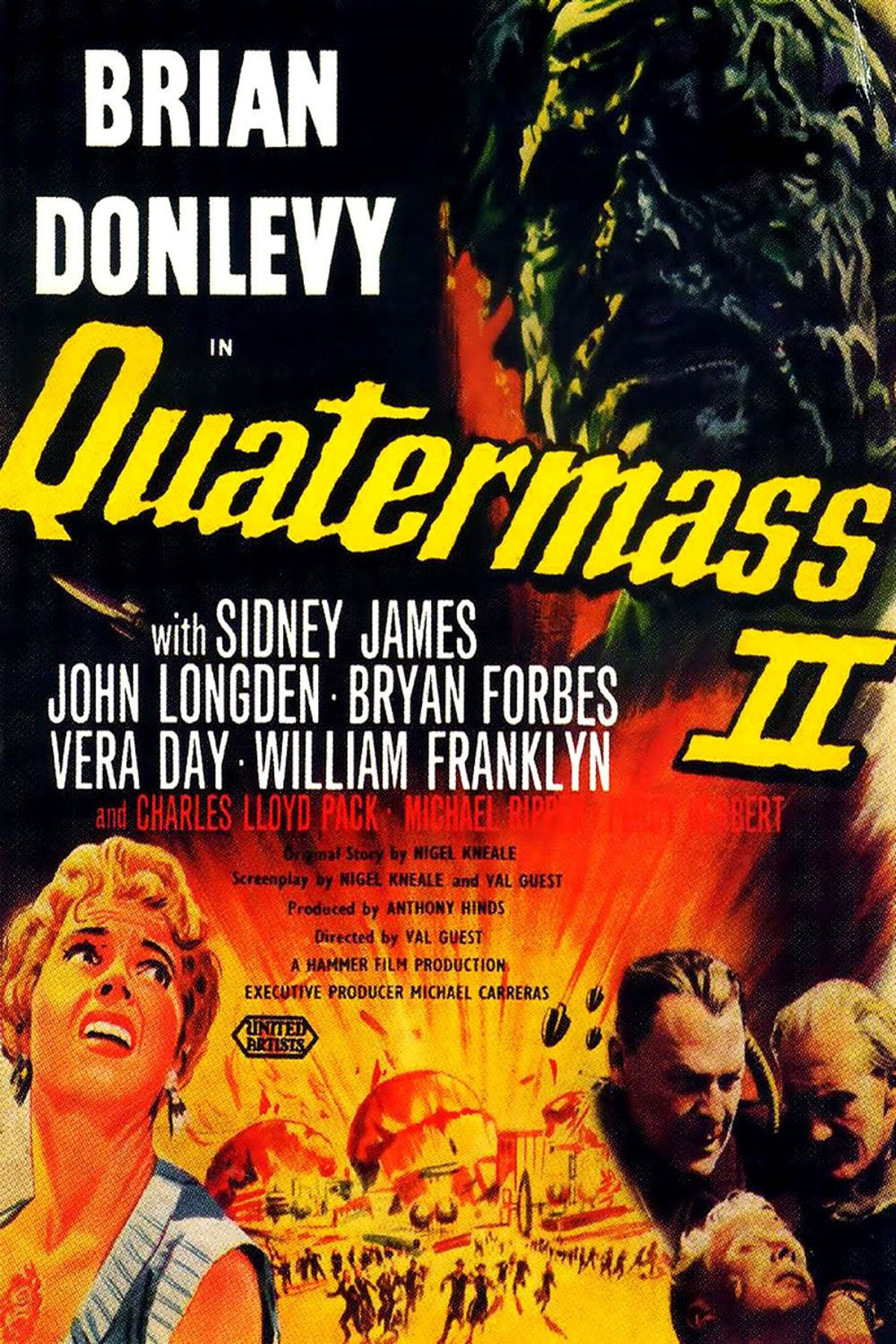
Strangely in London no one this time is moved by Quatermass’s bluster and bullying. Quatermass draws the only conclusion possible, eh Erich. Yep, the aliens are at it. That, by the way, would explain a lot about Whitehall decision-making over the years.
After shouting at his subordinates for a while, Prof Q pays attention to the meteors, and now having nothing better to do, he scouts the location where they fell. Well, no, he cannot do that because it is fenced off in the manner of a German death camp. Moreover, the perimeter is patrolled by some very silent, icy, and heavily armed guards in get-up that is un-English.
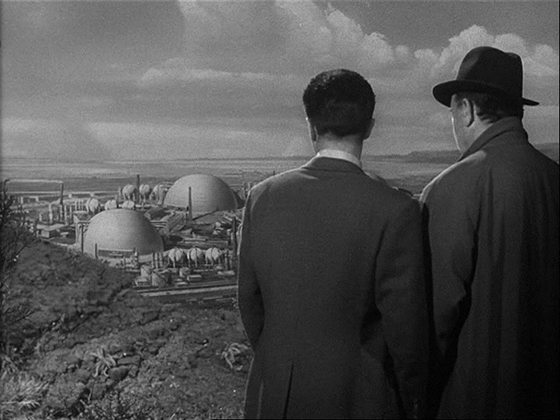 A conveniently located viewing platform offers perspective to the Prof.
A conveniently located viewing platform offers perspective to the Prof.
These guards spirit away the hapless assistant who drove Quatermass to the locale, and as Quatermass goes all Alpha Male on them, one steps forward and hits him with the butt of a gun. Down went Prof Q to the cheers of the fraternity brothers. ‘About time someone told him where to get off for assigning all that homework over Easter,’ they cried! Aside: all profs look alike to the fraternity brothers.
The meteors are eggs that hatch out a gas that infects humans, turning them into slaves. The word ‘zombies’ is used once, but oddly not the word ‘Republicans.’ The slaves built in a day or two the great complex Quatermass espied before his lights went out. When he recovers he rushes about, partly to find his assistant who has the keys to the WC, and to divert funding from this mystery project back to his own KPIs.
More doors are slammed in his face. Ah ha! It is a vast conspiracy. Yep the ‘Invaders’ (1967) have been at it a decade before Roy Thinnes came along, and most positions of authority are occupied by Republicans aka aliens! Look at those little fingers! Proof positive!
There is a fabulous scene where a delegation is being shown around the facility and a parliamentarian wonders off and is slimmed! Slimmed! There are many striking touches like this in the film. But consider what does it take to slime a politico.
Sid James appears as a sotten journalist who telephones in the story from the local pub, only to be mowed down by the aforementioned security guards. Witnessing this murder, shakes up the locals and to calm down they watch ‘Frankenstein’ (1931) and get an idea. They gather with torches, pitchforks, straw hats, darts, and other accoutrements of rural life to march on the mystery site.
Mayhem ensues around a Shell Oil refinery. Quatermass just happens to arrive to boss everyone around. Meanwhile, his deputy, Bryan Forbes, launches the rocket and somehow this disconcerts the alien protoplasm. Forbes went behind the camera to direct later in his career.
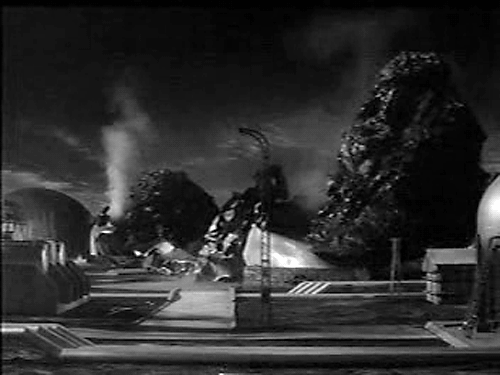 The protoplasm which looks like that of the earlier ‘Quatermass Experiment.’ He needs an autoclave in his laboratory to clean up and prevent such growths.
The protoplasm which looks like that of the earlier ‘Quatermass Experiment.’ He needs an autoclave in his laboratory to clean up and prevent such growths.
At no time does Q try to negotiate with the amoebas. A big BOOM follows. Catastrophe averted, yes, but Quartermass strides off to prepare for the next one.
The Quatermass Franchise grew from Nigel Kneale’s typewriter first as serials on the BBC and then films. He was a very fine writer, some of whose other works are reviewed elsewhere on this blog. This script was filmed as a television series but it did not survive the BBC policy of taping over past productions. The director was Val Guest, who once again offers a masterclass in pace.
This outing presages much to follow in its paranoia, the mark of Cain on the humans who have succumbed to the aliens, the James Bond shoot out in the refinery, but also draws on the established tropes with those meteors. The obvious compareson is ‘Invasion of the Body Snatchers’ (1956) which stole much of this film’s thunder in the North American market.
Scuttlebutt on the interweb street says Kneale and Guest argued about the character of Prof Q. Kneale wanted an avuncular English eccentric, but Guest wanted energy and tension in the part, and the producer wanted to sell the finished movie to the American market, so he wanted an American in the lead. Some of the more inane remarks, and that is a competitive field, on the IMDb blame Brian Donlevy, who played Quatermass, for the characterization, but it is obvious to anyone but a retard that the director did it. I guess the blunt, belligerent, brash, bossy, bullying, boorish, and bellicose Professor Quatermass was their idea of an American after having studied Dwight Eisenhower.
‘Mesa of Lost Women’ (1953)
The IMDb metadata is 1 hour and 10 minutes of Dali time, rated 2.5 by 1099 cinemitizens.
In the middle of El Muerte desert in Old Mexico Uncle Fester is conducting experiments to recreate Gale Sondergaard! ‘No chance,’ said the fraternity brothers, ‘she was one-off.’ Fester is splicing genes from an unlimited supply of spiders and an unlimited supply of Hollywood wanna-be starlets. The result was Tandra Quinn aka Tarantella! There were many others such women with Fester but only she had a name in the cast list. The others are termed, with admirable imagination, ‘Lost Woman.’ About ten of them. They were not even distinguished by a number like Lost Woman 1. The fraternity brothers hoped to find them when the lights came on.
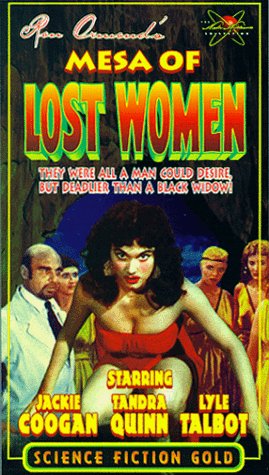
Two bumps upset Fester’s apple cart laboratory. First he awarded a nationally competitive research grant to a scientist to join his lab. Fine. When this aged Post Doc shows up, turns out, he doesn’t like this kind of gene splicing. What a sissy! He even recoils from the fifty-pound spider Fester keeps as a pet, an early experiment that did not work out quite right.
Second, an airplane crash lands on the mesa and brings onto the Rock of Otranto a mixed group of passengers and crew. They blunder around. Smoke cigarettes. Blame each other for the crash. Decry Republicans. And notice, slowly, that their number is being diminished.
Fester has sent his little men after the intruders. ‘Little men?’ Yes, a by product of splicing the spider women is the production of shrunken dwarfs as their paramours and ….. [Here the veil is drawn.]
The film was a boon for Hollywood’s dwarf population some of whom got a day’s work out of it. Likewise for the wanna-be starlets. Neither dwarf nor starlet had any lines. These human spiders, as Fester likes to call them, communicate by telepathy. Ergo, the actor’s minimum wage did not have to be paid.
This set-up has at least as much potential as ‘The Wild Women of Wongo,’ reviewed elsewhere on this blog, but the execution undermines any prospects it might have had. Though admittedly it is better than that film but then so is a blank screen.
It is told as a flashback within a flashback and the characters are undifferentiated so that the audience — me — was never quite sure who was whom, apart from Fester. The oil man who finds the couple wandering in the El Muete desert and the airplane pilot were identical twins on camera, but in the credits different guys. Oh.
Though the second scientist escapes from Fester’s Mesa later he just happens to the on the airplane that crashes on to the mesa. How easy is the scriptwriter’s life with such coincidences.
Equally coincidental Fester’s oriental servant is one of one of the passengers on that plane, though he is not a dwarf. How he got from the laboratory in one scene to sitting on the airplane in the next is down to the magic of the scriptwriter’s typewriter.
Within minutes of leaving the wrecked plane the just married bride among the passengers leaves her husband and goes into the bushes with the pilot for a anatomy lesson. She wants him to understand her. He does.
That second scientist, when he fled put miles between himself and the mesa, yet by coincidence he found Tarantella in the bar he walked into for a drink. After he shot her dead, she got up and left. Spider women never die! He then boarded the airplane to….the Mesa of Lost Time.
Yet later they all die in a fire started by our hero, whoever that was.
Throughout the mish-mash are interspersed for no discernible reason close-ups of Fester, perhaps he is using You Telepathy Tube, but who knows. There are also a number of equally pointless close up of the wanna-be’s larded into the proceedings. The fraternity brothers will explain those transactions to anyone who writes in and asks nicely. The dwarfs don’t get many close-ups.
There is an intrusive musical score that sets teeth on edge. It consists of three chords on a guitar repeated without purpose or end, punctuated now and then by a vase falling on a piano keyboard. Half-way through the fraternity brothers formed a lynch mob and set out to find the composer.
The direction is haphazard, if existent. The production values came fo Filene’s Basement. Fester is too low key to laugh at. Most of the cast are described on the IMDb with this phrase, ‘little remembered.’ Yep. For most of them this film was the apex of their career.
This movie is another example, among many, of the overlap of the genres science fiction and horror. There is ostensibly science in Fester’s lab explained with dialogue, but the results are horrible. Well not so horrible as to require expensive make up and costly special effects. Though, admittedly, the finger nails take seeing.
